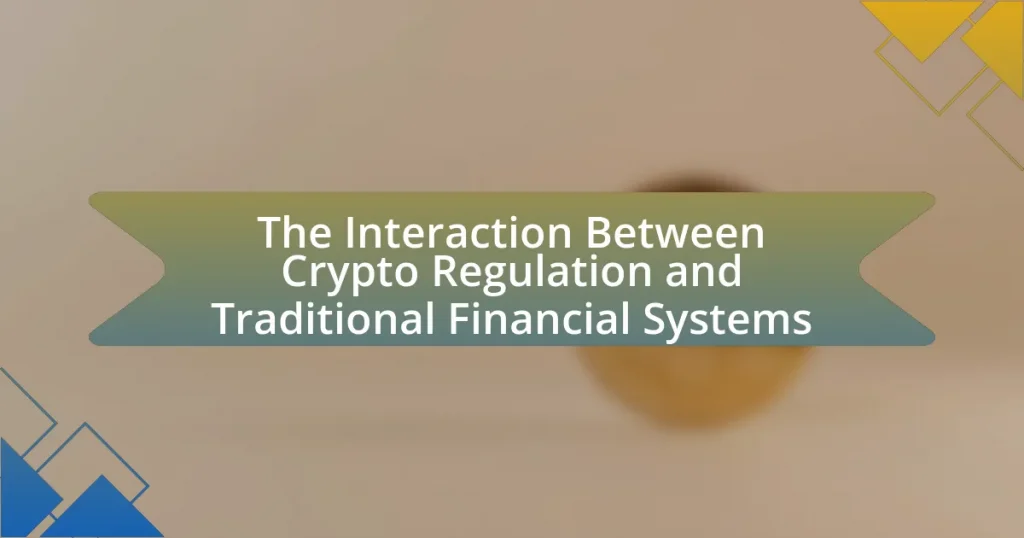The article examines the interaction between crypto regulation and traditional financial systems, highlighting the complex relationship where regulatory frameworks aim to integrate cryptocurrencies while ensuring consumer protection and financial stability. It discusses the impact of regulations on traditional financial institutions, including compliance costs and operational adjustments, and outlines key regulatory frameworks such as the FATF guidelines and the EU’s MiCA regulation. The article also addresses the risks posed by unregulated cryptocurrencies, the evolving relationship between crypto and traditional finance, and the emerging trends in the regulatory landscape. Additionally, it explores best practices for financial institutions to navigate these changes and leverage opportunities in the crypto space.

What is the Interaction Between Crypto Regulation and Traditional Financial Systems?
The interaction between crypto regulation and traditional financial systems involves a complex relationship where regulatory frameworks aim to integrate cryptocurrencies into existing financial structures while ensuring consumer protection and financial stability. Regulatory bodies, such as the Financial Action Task Force (FATF), have established guidelines that require traditional financial institutions to comply with anti-money laundering (AML) and know-your-customer (KYC) regulations when dealing with cryptocurrencies. This integration is evidenced by the increasing collaboration between banks and cryptocurrency exchanges, as seen in the rise of crypto custody services offered by major financial institutions like Fidelity and Goldman Sachs. These developments indicate a trend towards harmonizing regulatory standards, which can enhance the legitimacy of cryptocurrencies within traditional finance while addressing risks associated with fraud and volatility.
How do crypto regulations impact traditional financial systems?
Crypto regulations significantly impact traditional financial systems by introducing compliance requirements that financial institutions must adhere to when dealing with cryptocurrencies. These regulations can lead to increased operational costs for banks and financial services as they implement necessary measures to comply with anti-money laundering (AML) and know your customer (KYC) protocols. For instance, the Financial Action Task Force (FATF) guidelines mandate that financial institutions monitor cryptocurrency transactions, which can strain resources and alter existing workflows. Furthermore, regulatory clarity can foster greater integration of cryptocurrencies into traditional finance, as seen in countries like Switzerland, where clear regulations have encouraged banks to offer crypto services, thus enhancing market participation and innovation.
What are the key regulatory frameworks governing cryptocurrencies?
The key regulatory frameworks governing cryptocurrencies include the Financial Action Task Force (FATF) guidelines, the European Union’s Markets in Crypto-Assets (MiCA) regulation, and the U.S. Securities and Exchange Commission (SEC) regulations. The FATF provides a global standard for anti-money laundering (AML) and combating the financing of terrorism (CFT) that member countries are encouraged to implement, impacting how cryptocurrencies are regulated worldwide. MiCA aims to create a comprehensive regulatory framework for digital assets within the EU, ensuring consumer protection and market integrity. The SEC regulates cryptocurrencies under existing securities laws, determining whether specific tokens qualify as securities, which influences their trading and issuance. These frameworks collectively shape the legal landscape for cryptocurrencies, ensuring compliance and fostering trust in the market.
How do these frameworks differ across various jurisdictions?
Crypto regulation frameworks differ significantly across various jurisdictions, primarily due to differing legal interpretations, regulatory priorities, and economic contexts. For instance, the United States employs a fragmented approach where agencies like the SEC and CFTC regulate different aspects of cryptocurrencies, while the European Union is moving towards a more unified regulatory framework through the Markets in Crypto-Assets (MiCA) regulation. In contrast, countries like China have implemented outright bans on cryptocurrency transactions, reflecting a more restrictive stance. These differences are influenced by factors such as the level of financial innovation, consumer protection concerns, and the desire to maintain monetary sovereignty, which can be seen in the varying degrees of acceptance and integration of cryptocurrencies into traditional financial systems.
Why is the interaction between crypto regulation and traditional finance important?
The interaction between crypto regulation and traditional finance is important because it ensures the stability and integrity of financial markets. As cryptocurrencies gain popularity, their integration into traditional financial systems poses risks such as market volatility and fraud. Regulatory frameworks help mitigate these risks by establishing guidelines that protect consumers and promote transparency. For instance, the Financial Action Task Force (FATF) has issued guidelines that require financial institutions to implement anti-money laundering measures for cryptocurrency transactions, thereby enhancing the overall security of the financial ecosystem. This interaction fosters trust among investors and encourages the responsible adoption of digital assets within established financial structures.
What risks do unregulated cryptocurrencies pose to traditional financial systems?
Unregulated cryptocurrencies pose significant risks to traditional financial systems, primarily through increased volatility, potential for fraud, and challenges to monetary policy. The lack of regulatory oversight can lead to extreme price fluctuations, as seen in Bitcoin’s price swings, which can destabilize markets and erode investor confidence. Additionally, unregulated cryptocurrencies facilitate illicit activities, such as money laundering and tax evasion, undermining the integrity of financial systems. For instance, a 2021 report by the Financial Action Task Force highlighted that cryptocurrencies were increasingly used in criminal activities, posing a threat to financial stability. Furthermore, the absence of consumer protections in unregulated markets can lead to significant financial losses for individuals, further straining traditional financial institutions that may have to absorb these losses.
How can regulation enhance the stability of financial markets?
Regulation enhances the stability of financial markets by establishing rules that govern market behavior, thereby reducing risks associated with fraud, manipulation, and systemic failures. For instance, regulations such as the Dodd-Frank Act in the United States were implemented post-2008 financial crisis to increase transparency and accountability among financial institutions, which has contributed to a more stable financial environment. Additionally, regulatory frameworks often require financial entities to maintain adequate capital reserves, which helps absorb losses during economic downturns, further promoting market stability.
What challenges arise from the interaction between crypto regulation and traditional financial systems?
The interaction between crypto regulation and traditional financial systems presents challenges such as regulatory uncertainty, compliance costs, and the potential for market fragmentation. Regulatory uncertainty arises because differing jurisdictions may impose varying rules, leading to confusion for financial institutions trying to navigate compliance. Compliance costs increase as traditional financial entities must invest in systems and processes to meet both crypto-specific regulations and existing financial regulations, which can strain resources. Additionally, market fragmentation occurs when inconsistent regulations lead to a lack of interoperability between crypto and traditional systems, hindering seamless transactions and integration. These challenges can impede innovation and limit the growth of the crypto market within the broader financial ecosystem.
How do regulatory uncertainties affect market participants?
Regulatory uncertainties significantly impact market participants by creating an unpredictable environment that affects investment decisions and operational strategies. When regulations are unclear or subject to change, market participants, including investors and businesses, may hesitate to engage fully in the market due to the risk of non-compliance or financial loss. For instance, a survey by the International Monetary Fund in 2021 indicated that 70% of financial institutions cited regulatory uncertainty as a major barrier to adopting cryptocurrency technologies. This hesitance can lead to reduced market liquidity and slower innovation, as firms may choose to delay projects or investments until regulations are clarified.
What are the implications for financial institutions adapting to crypto regulations?
Financial institutions face significant implications when adapting to crypto regulations, including compliance costs, operational adjustments, and shifts in competitive dynamics. Compliance costs can be substantial, as institutions must invest in technology and personnel to meet regulatory requirements, which can strain resources. Operational adjustments are necessary to integrate crypto assets into existing systems, requiring updates to risk management frameworks and transaction processing capabilities. Additionally, the competitive landscape may shift, as institutions that effectively adapt to regulations can capture market share from those that lag behind, potentially leading to a consolidation of market power among compliant entities. These implications highlight the critical need for financial institutions to proactively engage with evolving regulatory frameworks to maintain their market position and ensure operational integrity.
How is the relationship evolving between crypto regulation and traditional financial systems?
The relationship between crypto regulation and traditional financial systems is evolving towards increased integration and collaboration. Regulatory bodies are recognizing the need to establish frameworks that accommodate cryptocurrencies while ensuring financial stability and consumer protection. For instance, the Financial Action Task Force (FATF) has implemented guidelines that require cryptocurrency exchanges to comply with anti-money laundering (AML) and know-your-customer (KYC) regulations, similar to traditional banks. This shift indicates a growing acceptance of cryptocurrencies within the financial ecosystem, as evidenced by major banks exploring blockchain technology and offering crypto-related services. Additionally, countries like the United States and the European Union are actively developing comprehensive regulatory frameworks to govern digital assets, further bridging the gap between crypto and traditional finance.
What trends are emerging in the regulatory landscape for cryptocurrencies?
Emerging trends in the regulatory landscape for cryptocurrencies include increased scrutiny from governments, the establishment of clearer regulatory frameworks, and a focus on consumer protection. Governments worldwide are implementing stricter regulations to combat money laundering and fraud, as evidenced by the Financial Action Task Force (FATF) guidelines that many countries are adopting. Additionally, regulatory bodies are working towards defining the legal status of cryptocurrencies, with countries like the United States and the European Union proposing comprehensive legislation to provide clarity on taxation and compliance. This shift aims to integrate cryptocurrencies into the traditional financial system while ensuring that consumer rights are protected, as seen in the European Union’s Markets in Crypto-Assets (MiCA) regulation, which seeks to create a unified regulatory approach across member states.
How are traditional financial institutions responding to the rise of cryptocurrencies?
Traditional financial institutions are increasingly adopting cryptocurrencies by integrating blockchain technology and offering crypto-related services. Major banks, such as JPMorgan and Goldman Sachs, have launched cryptocurrency trading desks and investment products, reflecting a shift towards accommodating digital assets. Additionally, many institutions are exploring partnerships with cryptocurrency exchanges to facilitate transactions and enhance customer offerings. This response is driven by the growing demand for digital currencies among consumers and investors, as evidenced by a 2021 survey from the Bank for International Settlements, which found that 70% of central banks are researching or developing central bank digital currencies (CBDCs).
What best practices can be adopted for navigating the interaction between crypto regulation and traditional financial systems?
To navigate the interaction between crypto regulation and traditional financial systems, institutions should adopt a proactive compliance strategy that includes continuous monitoring of regulatory developments and engagement with regulators. This approach ensures that financial entities remain informed about evolving regulations, such as the Financial Action Task Force (FATF) guidelines, which emphasize the importance of anti-money laundering (AML) and know-your-customer (KYC) practices in the crypto space. By implementing robust compliance frameworks that align with both crypto-specific regulations and traditional financial laws, organizations can mitigate risks and enhance their operational integrity. Additionally, fostering collaboration between crypto firms and traditional financial institutions can facilitate knowledge sharing and innovation, ultimately leading to a more integrated financial ecosystem.
How can financial institutions ensure compliance with evolving regulations?
Financial institutions can ensure compliance with evolving regulations by implementing robust compliance management systems that adapt to regulatory changes. These systems should include continuous monitoring of regulatory updates, employee training programs, and the integration of advanced technologies such as artificial intelligence for real-time compliance checks. For instance, a study by the International Monetary Fund in 2021 highlighted that institutions employing automated compliance tools experienced a 30% reduction in compliance-related costs, demonstrating the effectiveness of technology in maintaining regulatory adherence.
What strategies can be implemented to leverage opportunities in the crypto space?
To leverage opportunities in the crypto space, investors and businesses should adopt strategies such as diversifying portfolios with a mix of established cryptocurrencies and emerging tokens, engaging in regulatory compliance to build trust, and utilizing blockchain technology for transparency and efficiency. Diversification reduces risk and increases potential returns, as evidenced by the performance of Bitcoin and Ethereum compared to lesser-known altcoins. Regulatory compliance is crucial; firms that adhere to regulations can access broader markets and attract institutional investors, as seen in jurisdictions like Switzerland, which has fostered a favorable environment for crypto businesses. Additionally, implementing blockchain solutions can streamline operations and reduce costs, with companies like IBM demonstrating significant efficiency gains through blockchain applications.















